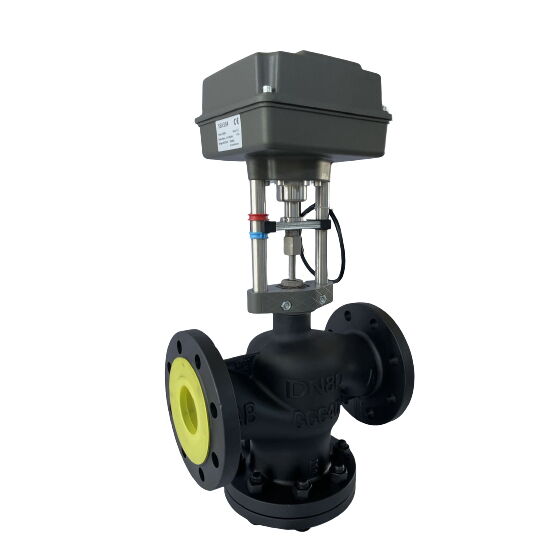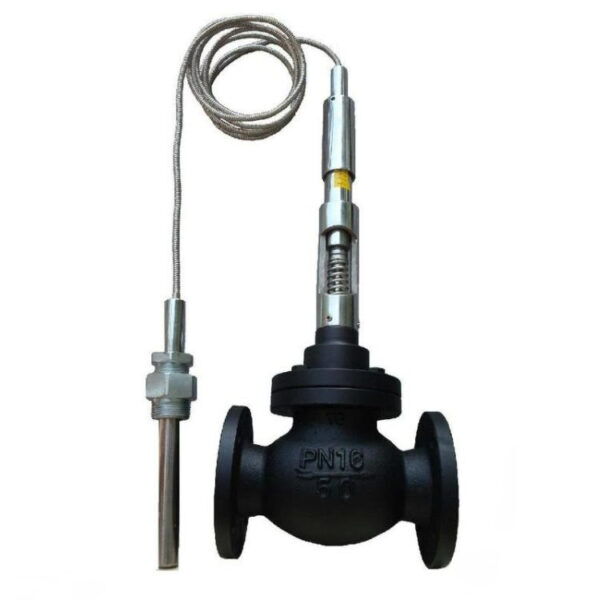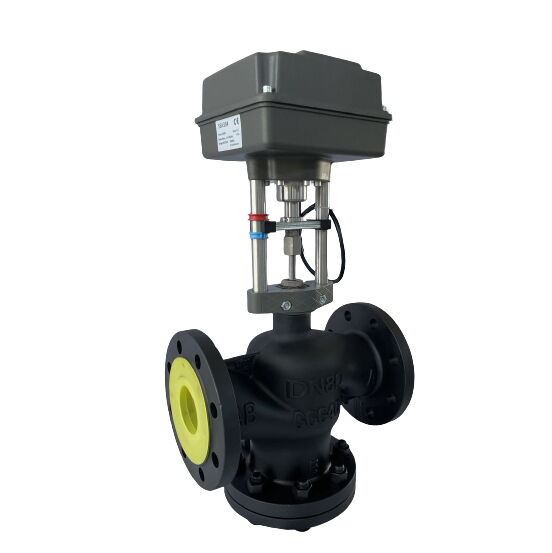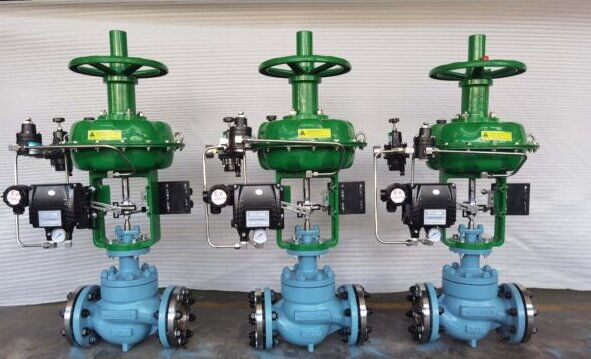
Temperature control valves, often referred to as temperature regulators, are critical components in the process control industry. These valves are designed to maintain process temperatures at a specific level, ensuring optimal performance in various applications. Unlike other control valves, temperature control valves are specifically engineered to regulate the temperature of fluids in systems such as compressors, engine jacket water, turbines, and cogeneration systems. They play a vital role in maintaining the efficiency and safety of these systems by controlling varying temperatures and ensuring proper cooling.
Temperature control valves are categorized based on the number of ports they possess. For instance, a valve with two ports is known as a 2-way valve, while one with three ports is referred to as a 3-way valve. These valves are indispensable in industries where precise temperature regulation is crucial, such as power generation, chemical processing, and HVAC systems.
Regular inspections are the foundation of effective temperature control valve maintenance. These inspections should be conducted systematically and include a comprehensive visual examination of the valve and its associated components. During the inspection, it is essential to look for signs of wear, corrosion, or leaks around the valve body and connections. Any abnormalities should be addressed promptly to prevent further damage and ensure the valve's continued performance.
In addition to visual inspections, it is also important to check the valve's operational performance. This can be done by monitoring the system's temperature readings and comparing them to the desired setpoints. Any discrepancies may indicate a malfunctioning valve that requires immediate attention.
Over time, temperature control valves can accumulate debris, scale, or corrosion, which can obstruct flow and impair temperature regulation. Regular cleaning is therefore essential to maintain the valve's performance and prevent malfunctions. Cleaning procedures should include flushing the valve and its associated piping to remove any contaminants that may have built up.
When cleaning temperature control valves, it is important to use appropriate cleaning agents and techniques to avoid damaging the valve's components. For instance, abrasive materials should be avoided as they can scratch or erode the valve's surfaces. Instead, gentle cleaning solutions and soft brushes should be used to remove debris without causing harm.
Temperature control valves often contain mechanical components such as actuators and linkages that require regular lubrication to function smoothly. Proper lubrication reduces friction and wear, extending the valve's lifespan and ensuring reliable operation. It is crucial to follow the manufacturer's guidelines regarding lubrication intervals and the types of lubricants to use.
When applying lubricant, it is important to ensure that it is evenly distributed across all moving parts. Over-lubrication should be avoided as it can attract dirt and debris, leading to potential blockages or malfunctions. Regular lubrication checks should be part of the maintenance routine to keep the valve in optimal condition.
Maintaining thorough records of all maintenance activities is essential for effective temperature control valve management. Documentation should include details such as inspection dates, cleaning schedules, lubrication applications, and performance test results. These records provide valuable insights into the valve's history and can help identify patterns or recurring issues that may require attention.
Proper documentation also facilitates compliance with industry regulations and standards. It ensures that all maintenance activities are carried out in a timely and systematic manner, reducing the risk of unexpected failures and downtime. Additionally, well-maintained records can be useful for troubleshooting and diagnosing problems, making it easier to implement corrective actions.
Temperature control valves come in various types, each designed for specific applications and operating conditions. Understanding the different types of valves can help in selecting the most suitable one for a particular system. The main types of temperature control valves include:
Direct-acting temperature valves are simple and reliable devices that operate without the need for external power sources. They use a temperature-sensitive element, such as a wax-filled capsule, to control the valve's position. As the temperature changes, the element expands or contracts, adjusting the valve's opening to regulate the flow of fluid. These valves are commonly used in applications where precise temperature control is not critical.
Self-operated temperature valves are similar to direct-acting valves but offer more precise control. They use a temperature sensor and a control mechanism to adjust the valve's position based on the temperature of the fluid. These valves are often used in applications where maintaining a specific temperature is essential, such as in heating and cooling systems.

Electric temperature control valves use electric actuators to adjust the valve's position based on signals from a temperature controller. These valves offer high precision and can be integrated into automated control systems. They are commonly used in industrial applications where precise temperature regulation is required.

Pneumatic temperature control valves use compressed air to operate the valve's actuator. They are often used in hazardous environments where electric actuators may not be suitable. These valves offer reliable performance and can be used in a wide range of applications, including chemical processing and oil and gas industries.

Selecting the right temperature control valve for a specific application is crucial for ensuring optimal performance and longevity. Here are some tips to consider when choosing a temperature control valve:
Determine the specific requirements of the application, such as the desired temperature range, flow rate, and pressure conditions. This will help in selecting a valve that can meet these requirements effectively.
The type of fluid being controlled is an important factor in valve selection. Different fluids have different properties, such as viscosity and corrosiveness, which can affect the valve's performance. Ensure that the valve material is compatible with the fluid to avoid damage or malfunction.
Temperature control valves are made from various materials, including cast iron, brass, stainless steel, bronze, and carbon steel. The choice of material depends on factors such as media compatibility, temperature range, and pressure range. Select a material that can withstand the operating conditions of the application.
The size of the valve and its port configuration should match the system's requirements. A valve that is too small may restrict flow, while one that is too large may not provide precise control. Ensure that the valve's size and port configuration are appropriate for the application.
Different types of temperature control valves use different control mechanisms, such as direct-acting, self-operated, electric, or pneumatic. Choose a control mechanism that aligns with the application's requirements and the available resources.
If unsure about the best valve for a specific application, consult with experts or representatives from valve manufacturers. They can provide valuable insights and recommendations based on their experience and knowledge.
Temperature control valves are made from a variety of materials, each offering different properties and advantages. The choice of material depends on factors such as the type of fluid being controlled, the operating temperature and pressure, and the environment in which the valve will be used. Common materials used in temperature control valves include:
Cast iron is a durable and cost-effective material that is commonly used in temperature control valves. It is suitable for applications involving water, steam, and other non-corrosive fluids. However, cast iron is not recommended for use with corrosive fluids or in high-temperature environments.
Brass is a versatile material that offers good corrosion resistance and machinability. It is commonly used in temperature control valves for applications involving water, air, and other non-corrosive fluids. Brass valves are often used in HVAC systems and plumbing applications.
Stainless steel is a highly durable and corrosion-resistant material that is suitable for use in a wide range of applications. It is commonly used in temperature control valves for applications involving corrosive fluids, high temperatures, and high pressures. Stainless steel valves are often used in chemical processing, food and beverage, and pharmaceutical industries.
Bronze is a durable and corrosion-resistant material that is commonly used in temperature control valves for applications involving seawater, steam, and other corrosive fluids. Bronze valves are often used in marine and offshore applications.
Carbon steel is a strong and durable material that is commonly used in temperature control valves for high-pressure and high-temperature applications. It is suitable for use with non-corrosive fluids and is often used in power generation and oil and gas industries.
Temperature control valves are essential components in various industrial applications, ensuring precise temperature regulation and optimal system performance. Regular maintenance, including inspections, cleaning, lubrication, and proper documentation, is crucial for maintaining the valve's efficiency and longevity. Understanding the different types of temperature control valves and their materials can help in selecting the most suitable valve for a specific application. By following the tips and guidelines outlined in this article, you can ensure that your temperature control valves operate reliably and effectively, contributing to the overall success of your systems.
For further assistance or a free consultation on selecting the right temperature control valve for your needs, feel free to contact our representatives. We are here to help you make informed decisions and ensure the optimal performance of your temperature control systems.